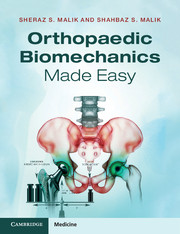Preface
Published online by Cambridge University Press: 05 June 2015
Summary
Orthopaedic Biomechanics Made Easy introduces you to the fundamental biomechanical principles in orthopaedics, and shows you how these relate to the clinical practice. The book seeks to fulfil two objectives:
To bring together important biomechanical concepts relevant to surgical practice.
To make these ideas simple and easy to learn.
Our efforts have been about taking you back to the first principles, and making them more interesting and fun to learn. We have avoided point-by-point references for this reason, as we feel that this might affect the reading experience.
To help you explore the subject, the book is signposted into three parts: Orthopaedic biomaterials and their properties; Engineering theory applied to orthopaedics; and, Clinical biomechanics. Each concept is introduced and explained in a discrete double-page spread. Consecutive sections are usually related and follow a common theme. Naturally, some ideas are more difficult than others, and we expect you to skip over them initially and to come back to them after covering the simpler topics. You do not need to deal with advanced maths to understand the presented biomechanical principles. Mathematical explanations are provided in some sections only to demonstrate how a particular biomechanical fact is derived. You may skip over the mathematical workings without missing out on the learning points.
- Type
- Chapter
- Information
- Orthopaedic Biomechanics Made Easy , pp. xiPublisher: Cambridge University PressPrint publication year: 2015



